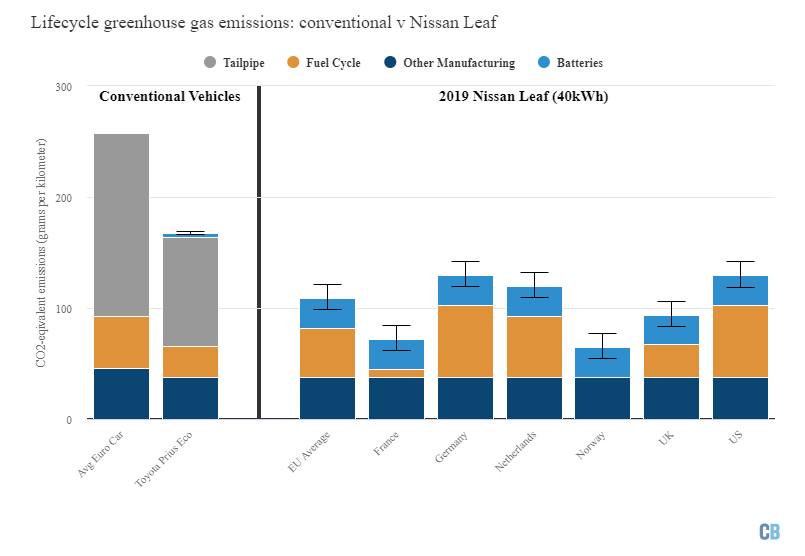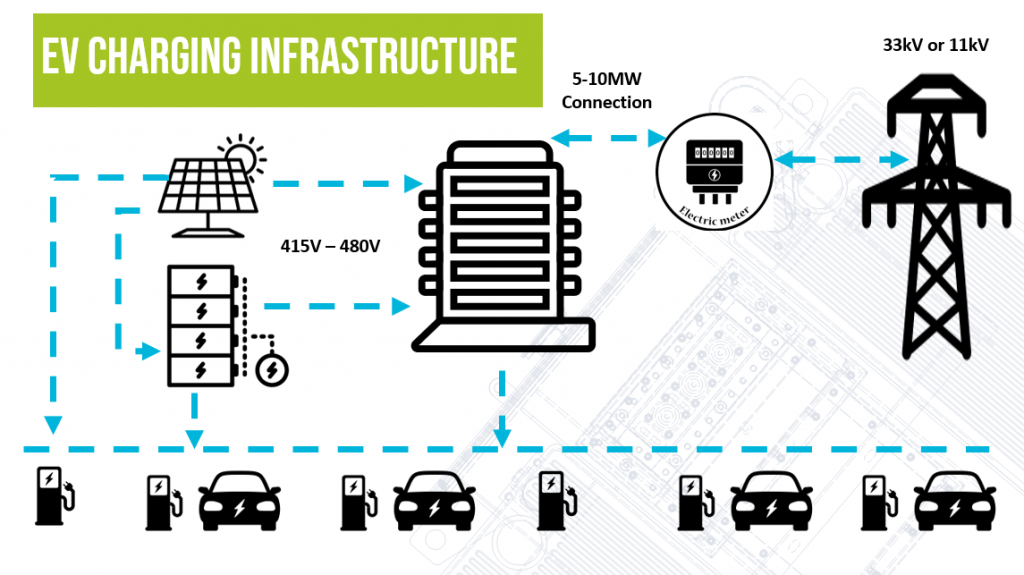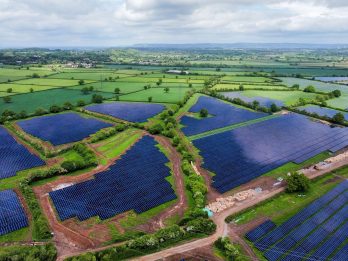Decarbonising EV Infrastructure & Case Study
There are almost 164,000 pure EV’s in the UK now (less than 0.5% of all cars) but we already have more charging points than petrol stations. It’s not exactly a straightforward comparison but it’s a good sign of a collaborative effort to equip the country with adequate infrastructure for the inevitable growth. The government’s “Green Industrial Revolution” and “Road to Zero” plans will ban internal combustion engine car sales by 2030. The average car stays on the road between (7-11 years), different fuel types and models live differently. But this means in the ’40s of this century, most cars on the UK roads will be electric vehicles.
How green are EVs?
Vehicle Lifecycle

Some argue that EVs are as bad as conventional cars. They attribute that to the “huge” emissions from mining, manufacturing and recycling/disposing batteries. The comparison on the right paints a clear picture of the level of emissions for each car type taking into consideration the lifecycle of the car.

Different car models comparisons produce different results but one thing we know for sure, EV’s are getting better and the carbon emissions of the lifecycle of them are getting lower and lower.
Carbon Intensity
The analysis shows that in the worst-case scenario in countries that rely heavily on fossil fuels to produce their electricity, EV’s carbon footprint is equivalent to the most efficient conventional cars or to hybrids. This takes us to carbon intensity, the deal-breaker.
Carbon intensity is the amount of carbon emitted into the atmosphere for every kWh generated. This relies mainly on the type of fuel (amongst things like transmissions & distribution losses). Different fuels have different carbon intensities, for example:
- Coal: 109gCO2e/kWh
- Hydropower: 97gCO2e/kWh
- CCGT: 78gCO2e/kWh
- Solar: 6gCO2e/kWh
- Wind/Nuclear: 4gCO2e/kWh
There are two carbon intensity targets in the UK, reaching 100gCO2/kWh by 2030 and 50gCO2/kWh by 2050. I think they are very low balled given that the IPCC recommends a 15gCO2e/kWh carbon intensity to meet the 2-degree limit.
So basically, your EV is as good as the electricity you use for charging it. And nowadays, there’s no excuse not to fix that with solar producing the cheapest electricity in history reaching as low as $20/MWh in places with supportive policies and incentives, 76% fall in lithium-ion prices between 2012 & 2019, on-shore wind in the UK (cheapest electricity generated from a new build), etc.
Further Decarbonisation
A mile driven in a medium-sized EV in the UK emits (0.08171 kgCO2/mile) 73% fewer carbon emissions than a mile driven in a same-sized petrol car (0.2992 kgCO2/mile ). We have 27% of further savings potential. Picking a low carbon fuel type can make a massive difference, another overlooked potential is through transformers.
Our Energy Policy Manager, Ayah Alfawaris, drew this abstract illustration for an EV charging infrastructure with a private connection to show where your distribution transformer(s) sit. Assuming you have a 5-10MW private connection, you will most likely have transformers. They are located behind your electric meter, so you pay for the energy losses your site endures because of these transformers. But most importantly, the carbon emissions of these losses are attributed to your site.

A quick calculation that shows that upgrading from the market standard transformer (Tier 1 losses) to Ultra Low Loss transformer (Wilson e3), you will save 19,415kWh annually. That equates to saving £2,912 & most importantly, avoiding 4.5tCO2 from being emitted into the atmosphere (assuming the tx is 1000kVA on a 70% load factor).
What does this mean in EV terms? 54,901 miles of extra EV charging at no extra cost or carbon emissions (considering a medium-size EV). These savings can be significantly higher if you have more than one transformer on site or if they have higher ratings & load factors.
Ultra Low Loss transformers are just one example of a decarbonisation measure for EV charging infrastructures. The road to Net Zero is not straightforward and every technological breakthrough needs to be part of the conversation. 1/3 of the global GHG come from energy and if we add transportation to that, it becomes 1/2 of the global GHG emissions. Reducing the footprint of these two sectors should be on the table of every decision making conversation.

Case Study: Gridserve
We supplied 2x Wilson e3 3000kVA transformers to Gridserve Braintree Forecourt, the UK’s first all EV charging service station. The station can charge up to 24 EV’s & 6 Tesla super chargers simultaneously with several 350kW Ultra Rapid Charging points. The station is powered by solar PV & battery storage. It provides “world class” customer experience with brands like WHSmith, Costa Coffee, the Post Office, Booths and Gourmade.
Our transformers are expected to save Gridserve 1,625MWh over 30 years of operations. This equates to £243k and 375 tCO2 emissions reduction. This would be enough to provide 4,590,525 EV miles (extra charging at zero emissions).
 25 Jan 2021
25 Jan 2021IETF: Industrial Energy Transformation Fund – Phase 3
Industrial emissions account for around 18% of UK emissions. To reach the Net Zero target in 2050, industrial emissions need to fall by around 90% from today’s levels. Industrial Energy Transformation Fund (IETF) launched Phase 3 of industrial grants on Monday 29 January 2024, with the closing date on Friday 19 April 2024, and aims […]
 23 Feb 2024
23 Feb 2024Guide to Replacing Transformers
The third part of the Intergovernmental Panel on Climate Change (IPCC) Sixth Assessment Report (AR6) was published earlier this month. Scientists warn that limiting global warming to 1.5°C is beyond reach but restricting temperature rise to no more than 1.5C to 2C could be the range that will minimize the likelihood of reaching critical environmental […]
 22 Apr 2022
22 Apr 2022IETF: Industrial Energy Transformation Fund FAQ
The Industrial Energy Transformation Fund (IETF) was designed by the UK government to encourage energy-intensive businesses to cut their carbon emissions and reduce their energy waste by switching to energy-efficient low-carbon technologies. A budget of £315 million was allocated by the government to be spent through the IETF. BEIS manages England, Wales and North Ireland’s […]
 4 Apr 2022
4 Apr 2022










